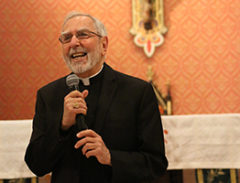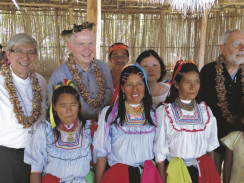By Christopher White
The Tablet National Correspondent
When Bishop Gerald Kicanas of Tucson, Arizona, officially hands over the reigns of his diocese to his successor next month, he says he’ll leave behind a place that seemed virtually in ruins when he got there, but which has now been remade.

In the spirit of Pope Francis, Bishop Kicanas is proud to boast that his diocese is eager to “share the journey” and to promote Christian discipleship in its totality. Such a mission, he says, requires both administrative savvy and an attractive witness to the Gospel – both of which have defined the bishop’s time in Tucson.
He arrived there in 2001 to serve as coadjutor bishop of the diocese right as the clergy sexual abuse crisis was close to a boiling point. Bishop Manuel Moreno, then the bishop, had been accused of sexual abuse cover-ups, and it was up to Bishop Kicanas to get the house in order.
In an interview with The Tablet, Bishop Kicanas described that period as “very painful” – expressing his affection for the man whom he replaced, but also a willingness to reckon with his faults.
He was a “warm, loving man who could not fathom that a priest would do this thing, especially priests he knew,” said Bishop Kicanas. “I was new to the diocese and didn’t know these men, so it was a little bit easier to be objective.”
Bishop Kicanas would go on to receive widespread praise for his handling of the abuse crisis, a critical step in rebuilding trust in the diocese he has led since 2003.
Growing up in Chicago in the 1940s and 50s, Bishop Kicanas always held the priesthood in high regard. His father grew up in an Indiana orphanage run by a Catholic priest – resulting in the elder Kicanas always telling folks (jokingly) that his father was a priest.
In third grade, the future bishop transferred to a Catholic school where a newly ordained priest and his eighth grade teacher, a religious sister, would encourage him to join the high school seminary.
Following high school, he enrolled in Chicago’s Mundelein Seminary where he would continue his priestly studies – although at times feeling torn between a call to the priesthood and a desire to enter the Peace Corps. Later, when he was ordained a bishop, he selected “Justice begets peace” as his episcopal motto, an acknowledgement of the key principles that had guided his vocation.
His first assignment after ordination was as a parish priest, where, he said, “I think I learned more about being a priest than in the seminary.”
From there, he would go on to serve as a religion teacher at the high school seminary and as a priest at a juvenile detention center in Chicago. His own father had been in that same center, and this work would serve as a formative experience as he witnessed firsthand the injustices of the criminal justice system.

In 1984, Bishop Kicanas was named rector of Mundelein Seminary, a post he held for over a decade until 1995 when he was named an auxiliary bishop under his mentor, Cardinal Joseph Bernardin, Archbishop of Chicago.
Cardinal Bernardin was one of the most instrumental figures within the Church in the years following Vatican II, perhaps best remembered for his “seamless garment” ethic, arguing that the Church must offer a consistent witness to the sacredness of human life, be it on issues of abortion, capital punishment, euthanasia, or anything else.
Upon arriving in Tucson, Bishop Kicanas immediately angered victims of sexual abuse who were outraged by his decision to move the diocese into bankruptcy.
“The advice I was given was that the only way to be objective in this situation – to be equitable and fair to victims – would be to move into bankruptcy so that anyone who had been abused would have access to some compensation,” he told The Tablet.
In retrospect, he feels vindicated by this decision, not out of personal pride, but because of the eventual response from those most affected by it.
“There had been a lot of anger from the victims who thought this was a cop out or a way of shirking responsibility – but the most moving thing for me was both the plaintiff’s lawyer and some of the victims that were there both said that they thought the process was fair and that their concerns were heard,” he said.
After coming out of bankruptcy, Bishop Kicanas knew that in order to rebuild the diocese, he would have to regain the trust of the faithful.
“We established a review board made up of laity who have the best interest of the Church, but also have this tremendous feeling of responsibility to make sure what we’re doing is providing safe environments, and I think this has been a huge blessing here,” he said.
“Drawing the laity into more significant roles of advice and counsel is something that is truly a blessing from the Second Vatican Council,” he added.
Another area where the Bishop has been eager to follow Vatican II’s call for the Church to be open to the modern world is in the realm of communications.
Bishop Kicanas was one of the first bishops to start his own blog, the “Monday Memo,” which has been well read within and outside of his diocese. In his work with the U.S. bishops’ communication committee, he’s long been a proponent for more – and better – communications within the Church.
“I put a high priority on communications,” he said. “I think we can’t over communicate.”
From 2007 to 2010, Bishop Kicanas served as vice president of the United States Conference of Catholic Bishops. In an unprecedented move, the bishops chose not to elect him as president of the conference in 2010, instead electing Archbishop Timothy Dolan of New York.
Such a move shocked Church observers, as it was the first time a sitting vice president of the conference had failed to be elected as president.
“I guess I’m famous for not having gone from vice-president to president,” he told The Tablet.
He described the outcome as “a surprise,” but also said he had his own misgivings as to whether he was the right person to lead the conference at the time.
Many considered the election of Archbishop Dolan over Bishop Kicanas as a rejection of the Cardinal Bernardin legacy, and an effort to move the conference in a more conservative direction.
“I know some people thought I was too liberal for the conference, whether that’s true or not, I honestly don’t know,” he said.
In the years after the 2010 USCCB election, religious liberty became a defining theme for the conference, criticized by some for its singular focus. Yet, in response to the Trump administration, many would argue the conference is shifting in a direction closer to that of Cardinal Bernardin, giving new priority to issues like immigration, racism, and healthcare.
“One of the most painful things for Cardinal Bernardin was when he tried to bring forth the Common Ground initiative (a call for Catholics to reject political polarization) and that was so harshly rejected by some of his peers,” said Bishop Kicanas.
Critics on the right felt Cardinal Bernardin was too soft on abortion, while those on the left thought he was too deferential to Church tradition.
“That was terribly painful for him, ’cause I think he saw it as healing some of the division and lack of harmony in the Church,” Bishop Kicanas said.
“I think there were some who felt that his approach, whether it was the seamless garment or the Common Ground initiative, was selling the Church short. I think it was the very opposite; it was his intention to help the Church relate to a world that was changing very rapidly, to hold up what we truly value and the core messages of who we really are as Church,” he added.
Twenty years after the death of Cardinal Bernardin, Bishop Kicanas believes his legacy is being vindicated by Pope Francis.
“I think Pope Francis is helping us to maybe move away from more of the neuralgic issues that are so polarizing, to see what truly being a disciple is about,” he said.
“Pope Francis is trying to help us get back to the realization that the beatitudes are indeed a road map of what it means to truly be a disciple,” said Bishop Kicanas. “There is a value to different opinions, but what’s happening now is we throw barbs at each other rather than trying to understand or hear the other’s perspective and understand it better.”
“It’s worrisome too that sometimes our seminarians are feeding on the polarity that is there and some of the nastiness toward the Holy Father… if anything, the Lord’s call is for unity and sometimes that’s not where we find ourselves,” Bishop Kicanas told The Tablet. “Some internet sites are quite alarming, and I know sometimes people see that as Church teaching, which is certainly not what it is.”
Looking ahead to the upcoming meeting of the U.S. bishops, he believes they are beginning to more closely reflect the priorities of Pope Francis.
“The focus is changing, so the issues of religious liberty and abortion are less prominent now with the current administration,” he said. “But things like immigration, healthcare, the poor – these fundamental teachings of the Church is where the Church has to speak up now.”
Bishop Kicanas plans to spend his retirement helping his successor, Bishop Edward Weisenburger, as he sees fit, along with continuing his prison ministry and speaking out when necessary.
“I’m not going to be an Uber driver, I don’t think,” he joked, “but it is a great way of meeting people,” he added.
At 76 years old, he believes there is still much work ahead – both for him and his brother bishops.
“We have to do more than talk and issue statements,” said Bishop Kicanas. “I think there is a need for some action that is clear.”
Bishop Kicanas points to the 2014 border Mass in which he joined Boston’s Cardinal Sean O’Malley and other U.S. bishops to bring attention to the plight of immigrants along the U.S.-Mexico border as one example and says he hopes to see more such examples in the near future.
“We have to have more Pope Francis-like actions,” he said.
